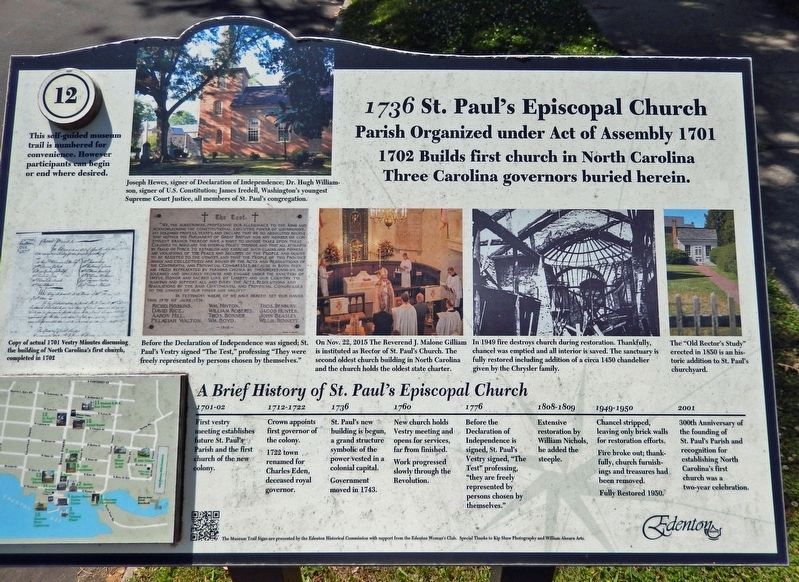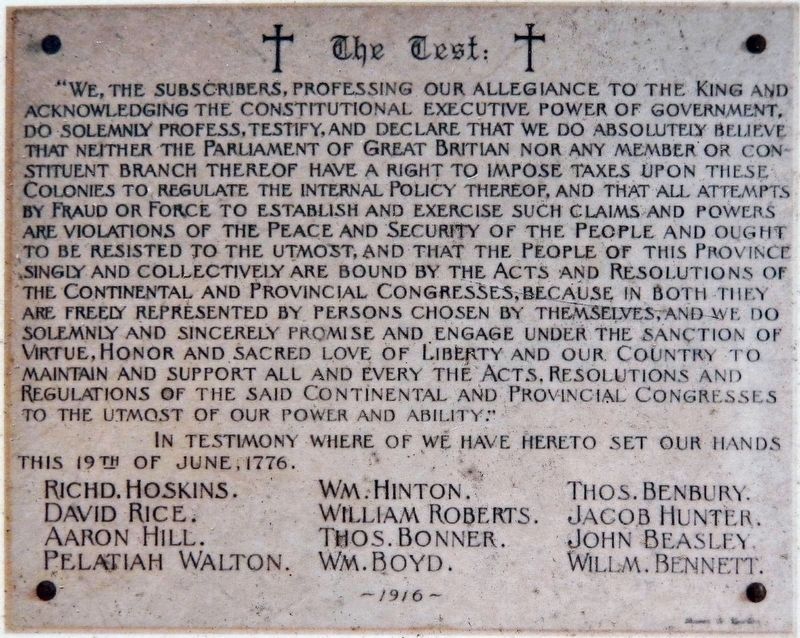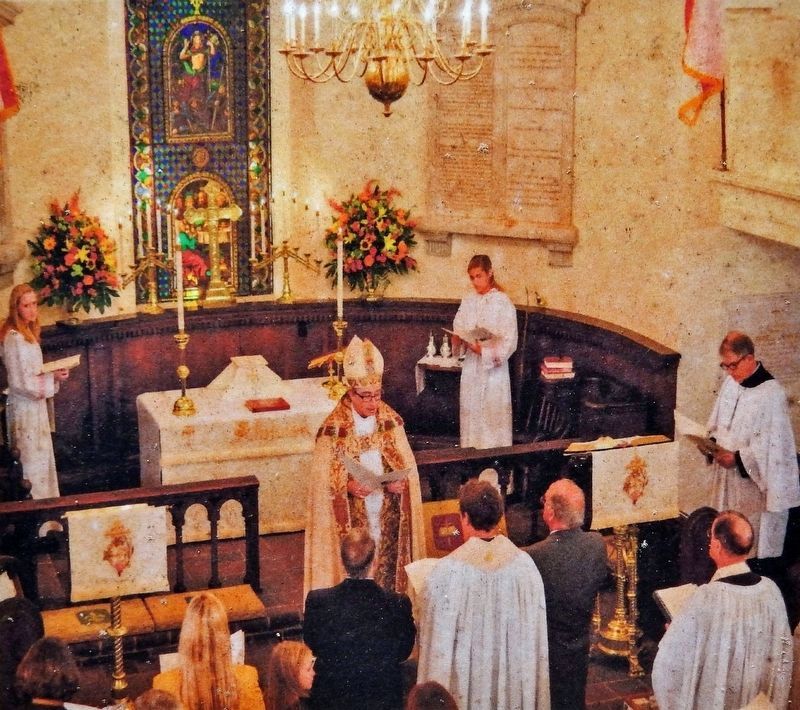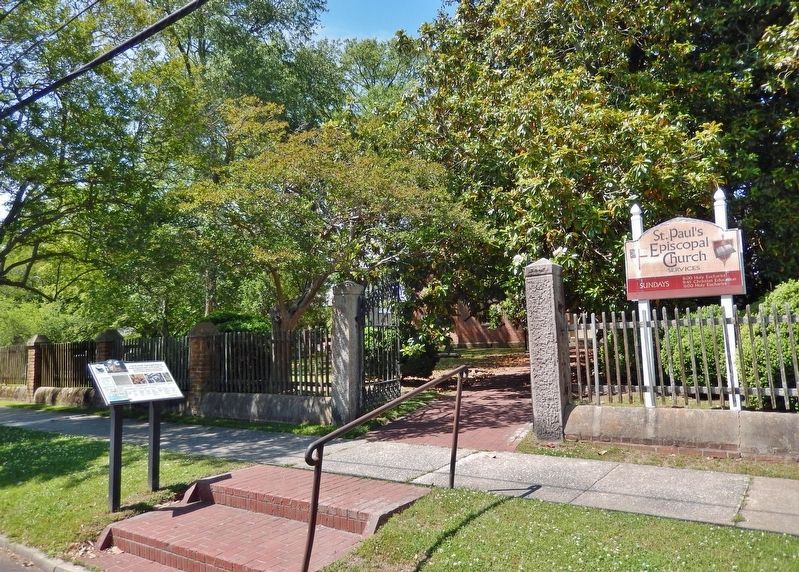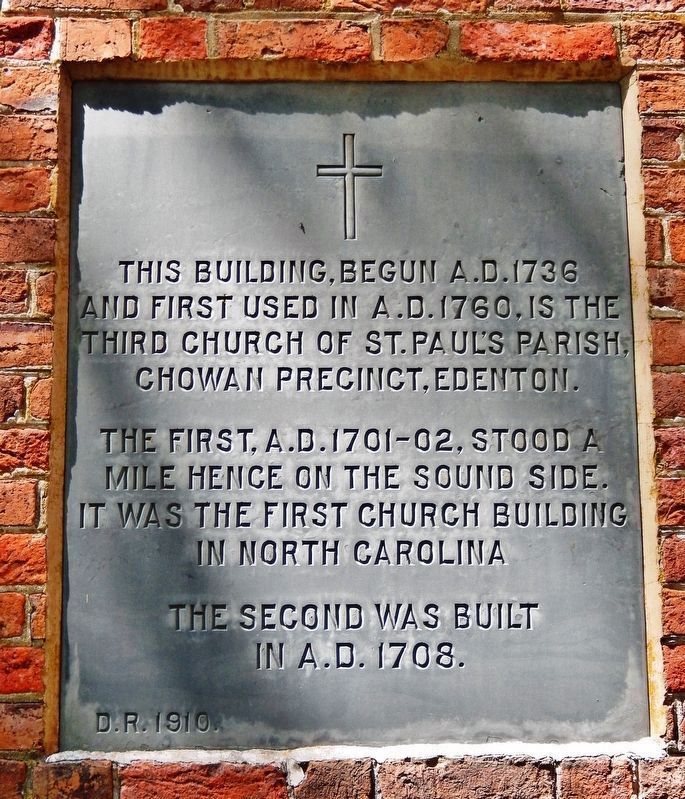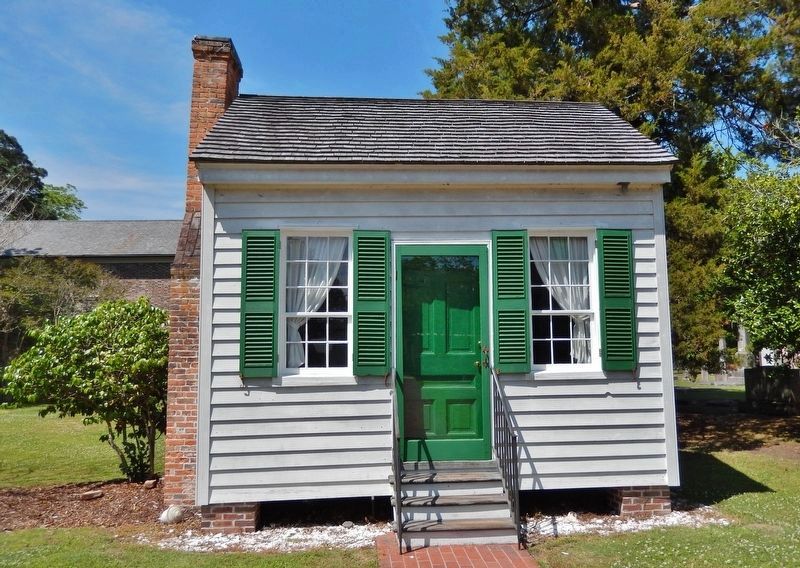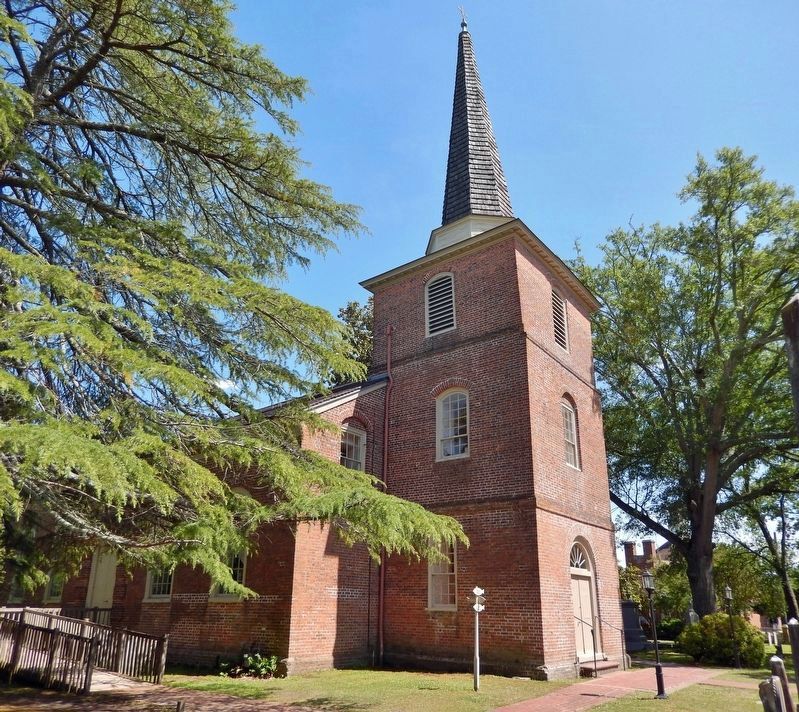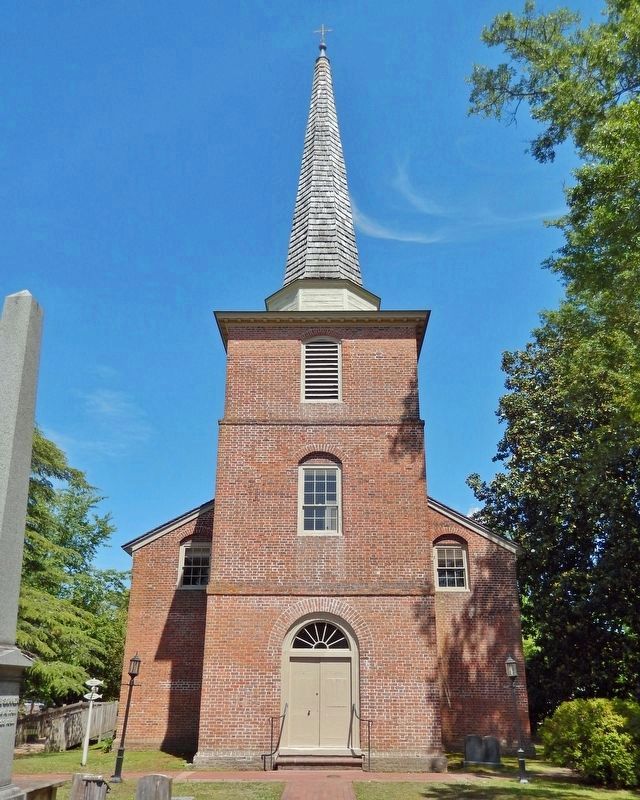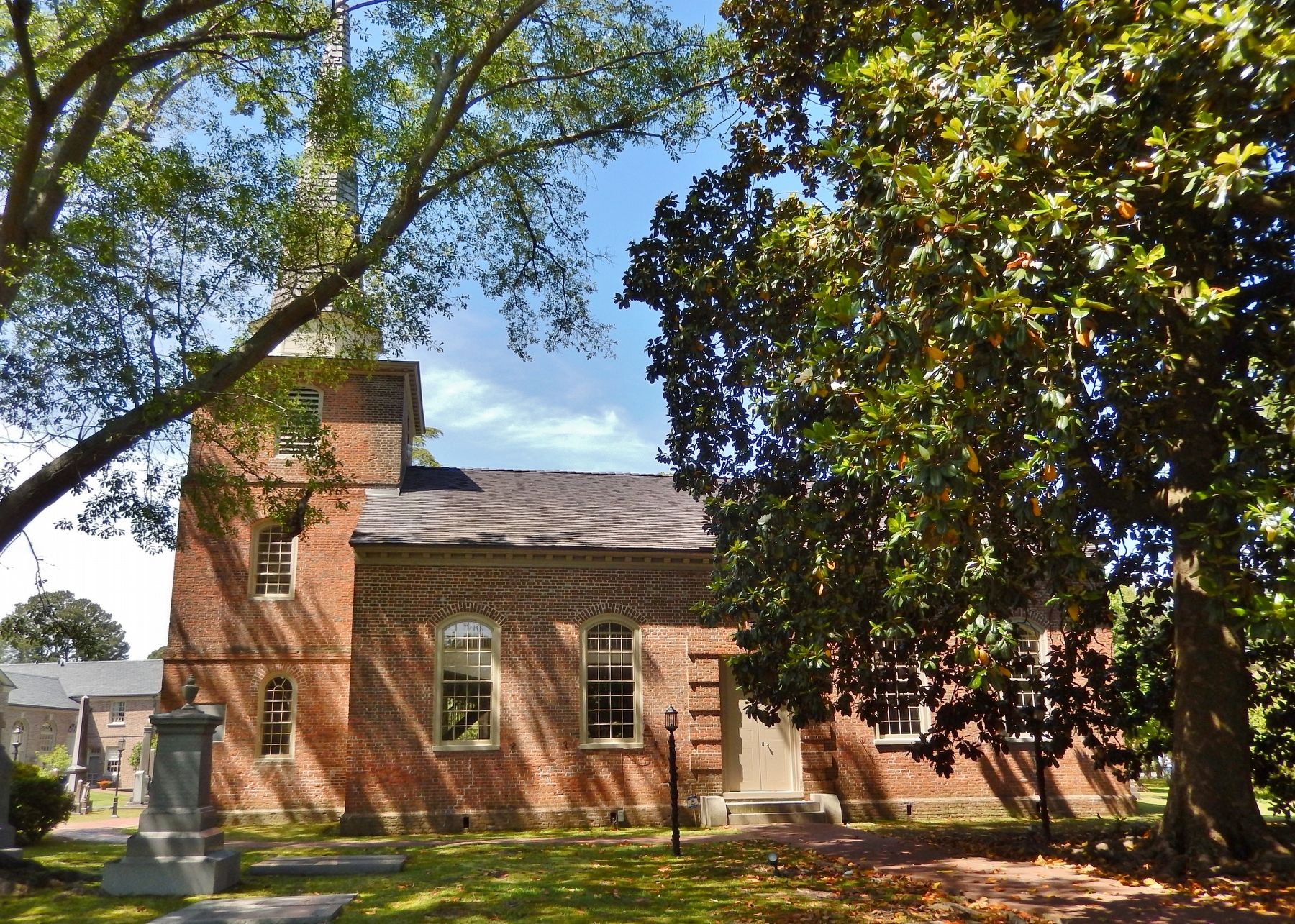Edenton in Chowan County, North Carolina — The American South (South Atlantic)
1736 St. Paul's Episcopal Church
Parish Organized under Act of Assembly 1701
— Edenton Historical Commission Museum Trail —
Three Carolina governors buried herein.
Joseph Hewes, signer of Declaration of Independence; Dr. Hugh Williamson, signer of U.S. Constitution; James Iredell, Washington's youngest Supreme Court Justice, all members of St. Paul's congregation.
A Brief History of St. Paul’s Episcopal Church
1701-02
First vestry meeting establishes future St. Paul's Parish and the first church of the new colony.
1712-1722
Crown appoints first governor of the colony. 1722 town renamed for Charles Eden, deceased royal governor.
1736
St. Paul's new building is begun, a grand structure symbolic of the power vested in a colonial capital. Government moved in 1743.
1760
New church holds Vestry meeting and opens for services, far from finished. Work progressed slowly through the Revolution.
1776
Before the Declaration of Independence is signed, St. Paul's Vestry signed, "The Test" professing, "they are freely represented by persons chosen by themselves."
1808-1809
Extensive restoration by William Nichols, he added the steeple.
1949-1950
Chancel stripped, leaving only brick walls for restoration efforts. Fire broke out; thankfully, church furnishings and treasures had been removed. Fully Restored 1950.
2001
300th Anniversary of the founding of St. Paul's Parish and recognition for establishing North Carolina's first church was a two-year celebration.
[other photo captions]
• Copy of actual 1701 Vestry Minutes discussing the building of North Carolina’s first church, completed in 1702.
• In 1949 fire destroys church during restoration. Thankfully, chancel was emptied and all interior is saved. The sanctuary is fully restored including addition of a circa 1450 chandelier given by the Chrysler family.
This self-guided museum trail is numbered for convenience. However participants can begin or end where desired.
The Museum Trail Signs are presented by the Edenton Historical Commission with support from the Edenton Woman’s Club. Special Thanks to Kip Shaw Photography and William Ahearn Arts.
Erected by Edenton Historical Commission Museum Trail. (Marker Number 12.)
Topics and series. This historical marker is listed in these topic lists: Architecture • Churches & Religion • Settlements & Settlers
• War, US Revolutionary. In addition, it is included in the Signers of the Declaration of Independence series list. A significant historical year for this entry is 1702.
Location. 36° 3.664′ N, 76° 36.522′ W. Marker is in Edenton, North Carolina, in Chowan County. Marker is on West Church Street just west of North Broad Street (State Highway 32), on the right when traveling west. Marker is located beside the sidewalk at the church grounds south entrance on Church Street. Touch for map. Marker is at or near this postal address: 101 West Gale Street, Edenton NC 27932, United States of America. Touch for directions.
Other nearby markers. At least 8 other markers are within walking distance of this marker. Joseph Hewes (within shouting distance of this marker); Samuel Johnston (within shouting distance of this marker); St. Paul's Episcopal Church (within shouting distance of this marker); James Iredell (within shouting distance of this marker); a different marker also named St. Paul's Episcopal Church (within shouting distance of this marker); Edenton United Methodist Church (within shouting distance of this marker); Chowan County Courthouse (about 300 feet away, measured in a direct line); Harriet Jacobs (about 400 feet away). Touch for a list and map of all markers in Edenton.
Regarding 1736 St. Paul's Episcopal Church.
National Register of Historic Places #75001248.
From the National Register Nomination:
The church is of brick, laid in Flemish bond except for the apse at the east end which is laid in all-header bond. The gable-roof nave is five bays wide. Each side elevation has a centrally placed entrance that is very handsomely treated. The flat-paneled double door is framed by rusticated brick quoins and topped by a three-part keystone, also in brick. The large windows in the remaining bays are segmental-arched, containing sixteen-over-sixteen sash. The elevations are defined by a brick water table and a molded cornice adorned with undercut modillions.
Related markers. Click here for a list of markers that are related to this marker. Edenton Historical Commission Museum Trail
Also see . . .
1. St. Paul's Church, Edenton.
St. Paul's Church is a five-bay, brick church building with a gable roof. It features a slightly engaged square tower. It is the second oldest church building in North Carolina, and the only colonial church still in regular parish use. The interior was restored to its 19th-century appearance following a fire in 1949. The churchyard has the tombs of governors Charles Eden (1673–1722), Thomas Pollock (1654–1722), and Gabriel Johnston (1699–1752).(Submitted on May 31, 2023, by Cosmos Mariner of Cape Canaveral, Florida.)
2. St. Paul's Episcopal Church.
The parish was organized in 1701 as the first parish in the colony. A post-in-ground church building was erected the next year on an undetermined plot of land just east of Queen Anne's Creek. By 1736, it was decided to build a new church in the bustling town of Edenton, which was also the colony's capital. Here, the church occupied the lots set aside for church and churchyard (cemetery) before 1722 and construction began on a brick building that followed a form popular in Virginia.(Submitted on May 31, 2023, by Cosmos Mariner of Cape Canaveral, Florida.)
3. A short history of St Paul’s.
Many of the Revolutionary leaders in this area were members of St Paul’s: Joseph Hewes, soon to be a signee of the Declaration of Independence; Thomas Jones, reputed writer of the constitution of the new state of North Carolina; James Iredell, later a justice of the first Supreme Court of the United States; and Samuel Johnston, first governor of the new state and later its Senator. The whole vestry on June 19, 1776, signed the Test, the new oath of allegiance of the colony to the king and constitutional government, which at the same time protested against unfair taxes, unjust meddling in colonial government, and other infractions of the rights(Submitted on May 31, 2023, by Cosmos Mariner of Cape Canaveral, Florida.)of free people.Photographed By Cosmos Mariner, May 17, 20235. St. Paul's Episcopal History Tablet(mounted near southwest corner of church) This building, begun in A.D. 1736 and first used in A.D. 1760, is the third church of St. Paul’s Parish, Chowan Precinct, Edenton.The first, A.D. 1701-1702, stood a mile hence on the sound side. It was the first church building in North Carolina.
The second was built in A.D. 1708.
D.R. 1910.
4. St. Paul's Episcopal Church National Register of Historic Places Nomination. (Submitted on May 31, 2023, by Cosmos Mariner of Cape Canaveral, Florida.)
Additional keywords. 1736 St. Paul's Episcopal Church
Credits. This page was last revised on June 7, 2023. It was originally submitted on May 30, 2023, by Cosmos Mariner of Cape Canaveral, Florida. This page has been viewed 78 times since then and 15 times this year. Photos: 1. submitted on May 30, 2023, by Cosmos Mariner of Cape Canaveral, Florida. 2, 3. submitted on May 31, 2023, by Cosmos Mariner of Cape Canaveral, Florida. 4. submitted on May 30, 2023, by Cosmos Mariner of Cape Canaveral, Florida. 5, 6, 7, 8, 9. submitted on May 31, 2023, by Cosmos Mariner of Cape Canaveral, Florida.
